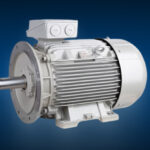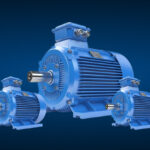DC motors have been a basic element of electromechanical conversion providing precise speed and torque control. Their versatility makes them important in various industrial & commercial applications. Learn about the working principles of DC motors, their types and applications.
Understanding DC Motors
A DC motor is an electromechanical device that changes direct current (DC) electrical energy to mechanical energy using electromagnetic interactions. Unlike AC motors that utilize alternating current DC motors move with controlled speed and torque precisely for applications where speed and torque regulation are required. These motors originated in the early 19th century with Michael Faraday and Thomas Davenport developing electromagnetic rotation.
Working Principle
The operation of a DC motor is based on the Lorentz force principle, which states that when a current-carrying conductor is placed within a magnetic field, it experiences a force perpendicular to both the field and current direction. This force generates the torque required for motor rotation.
A DC motor consists of several key components:
- Armature (Rotor): This is the rotating portion of the motor that changes electrical energy to mechanical motion.
- Stator: The stationary magnetic field source coming from permanent magnets or field windings.
- Commutator & Brushes: These components keep the direction of current in the armature windings changing periodically to maintain rotation in the same direction.
- Power Supply: Provides direct current for motor operation.
Whenever DC voltage is used on the armature, current runs through the windings producing an electromagnetic field. This field generates torque in the rotor that turns the stator. The commutator & brushes maintain the current flow direction constant to ensure motor operation.
Understanding Types

DC motors are classified according to the field winding placed on the armature. All types have suitable performance properties for particular applications.
A permanent magnet DC motor produces its magnetic field with permanent magnets rather than wound coils. This results in a small, light & efficient motor. These motors are found in applications requiring low to moderate torque like windshield wipers, HVAC and small robotics. They are more efficient & stable since they don’t require external field excitation.
In a shunt wound DC motor, the field winding is connected to the armature winding. This parallel connection maintains a constant speed of the motor regardless of load variations. Its steady speed performance makes shunt wound DC motors suitable for lathes, textile machines & centrifugal pumps. These provide quiet operation and are applicable in applications where speed stability is important.
A series-wound DC motor has its field winding connected in series with the armature. This particular configuration gives high starting torque making these motors appropriate to heavy-load applications. Nevertheless, a series wound DC motor speed goes down with increasing load. These motors are found in cranes, traction motors, elevators and battery-powered automobiles in which strong startup torque is needed.
A compound Wound DC motor has characteristics of both a shunt & series Motor. It has parallel in addition to series field windings and has a good balance between high starting torque & speed regulation. These motors are utilized for instance in rolling mills, printing presses, and mines. They can handle changing loads with excellent speed stability in demanding industrial applications.
A brushless DC motor eliminates the need for mechanical brushes and commutators by controlling current flow with an electronic controller. This results in higher efficiency, reduced maintenance & durability. BLDC motors find a significant application in electric vehicles, drones, medical equipment and modern home appliances due to their much longer life and energy efficiency.

Wide Range of Applications
- Industrial Machinery: Conveyor belt systems use Direct current motors for material handling, and mixers and grinders utilize them for uniform and precise operation in food process, pharmaceutical and chemical industries. Lathes & CNC are controlled precisely by DC motors for high-quality machining/metalworking.
- Automotive Industry: Electric vehicles utilize brushless DC motors because they’re very effective and torque-controlled. In conventional vehicles, starter motors utilize series-wound direct current motors to provide the high torque necessary for engine cranking. Also power windows and adjustable seats in cars are provided with small DC electric motor for quiet operation.
- Home Appliances: DC motors are found in household Appliances. Vacuum cleaners use high speed DC motor to give strong suction and blenders and food processors use them to change speed exactly. Contemporary fans and air conditioning systems utilize silent and effective brushless DC motors.
- Robotics and Automation: These motors are utilized for motion control & Automation in the robotics sector. Robotic arms in manufacturing employ precision controlled DC motor. Drones and uncontrolled aerial vehicles (UAV) propulsion is supplied by lightweight, effective brushless DC motors. Autonomous vehicles utilize direct current motors for movement & operation control – for example factory robots.
- Medical Equipment: A DC motor is also extremely important in medical Equipment because it calls for accuracy and reliability. High-speed direct current motors drive surgical tools like orthopedic tools and dental drills. Infusion pumps also utilize precise direct current motors to deliver medication safely.
Discover the Perfect Electric Motors for Your Needs
Advantages of DC Motors

DC electric motors have the advantage of speed adjustment. DC motors have direct voltage control, unlike AC motors. This is very useful in robotics, conveyor systems and industrial automation where fine-tuning of speed control is required.
DC motors especially series and compound wound types have high starting torque suitable for heavy-duty applications. Industries requiring immediate full-load torque – traction motors in trains, hoists in construction – and industrial cranes – use DC motors for large loads.
- Simple and Efficient Design:
Compared with AC motors, DC motors are simpler to maintain/repair. Brushless DC motors add dependability by keeping away from mechanical wear components like commutators and brushes. This design assures long-term durability & reduces operational downtime.
DC motor manufacturers are continually improving Efficiency with new motor designs which save power. Brushless DC motors use much less power than brushed counterparts and are thus suitable for energy savings applications including renewable energy systems and battery-powered equipment.
- Reliability and Durability:
Fewer moving parts ensure longer service life with minimal maintenance of DC motors. Explosion-proof DC motors are available for hazardous environments like mining, oil 1and1 gas, chemical processing etc. The robust construction makes DC motors long-lasting and therefore cost-effective in industrial applications.
Conclusion: Partnering with Shrirang Energy Efficient for Your DC Motor Needs
DC motors are fundamental for modern industry for their precision, efficiency and versatility. Their controlled motion, high torque and energy-efficient results make them essential in industrial automation, transport, medical fields and robotics. Understanding the various kinds of DC motors and their uses enables businesses to select the best motor for their application.
We at Shrirang Energy Efficient supply high-quality DC motors for various industrial applications. As a leading DC motor manufacturer & supplier, we provide standard DC motors, brushless DC motors, réduction gearboxes, blast-proof motors etc. Our partnerships with top brands like Crompton Greaves, Bharat Bijlee ABB, Havells and Siemens ensure that our clients get top-quality products at competitive prices. Explore our range of electric motors today!
Frequently Asked Question(FAQs):
Q1. How does a DC motor work?
A. DC motors operate based on the interaction between a magnetic field and an electric current, generating force in the form of torque applied to the motor’s shaft.
Q2. Can DC motors run on AC power?
A. No, DC motors require direct current (DC) power. though they may be operated with an external circuit to convert AC to DC using a rectifier.
Q3. What is the difference between brushed and brushless DC motors?
A. Brushed DC motors use mechanical brushes for commutation, while brushless DC motors utilize electronic commutation, offering higher efficiency and reduced maintenance.





